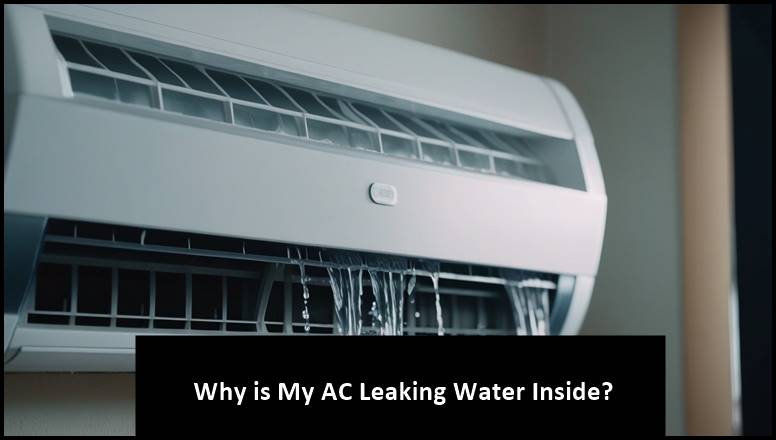Air conditioners are a vital component of maintaining a comfortable indoor environment. However, a common concern many homeowners face is, “Why is my AC leaking water inside?”
In this comprehensive guide, we’ll explore the reasons behind water leaking from the AC unit, signs to look out for, and effective solutions to address and prevent this issue.
Causes of AC Leaks
Clogged or Dirty Air Filter
One of the primary culprits behind water leaking from an air conditioner is a clogged or dirty air filter. When the filter becomes obstructed, it limits airflow, leading to the freezing of the evaporator coil, causing subsequent water leakage.
Blocked or Disconnected Drain Line
A blocked or disconnected drain line is another common culprit contributing to air conditioning leaking water. This issue often arises due to the growth of algae or mold, obstructing proper drainage and causing water backup.
Refrigerant Issues
Issues with refrigerant levels can also lead to water leakage from the air conditioner. Low refrigerant levels may cause the evaporator coil to freeze and subsequently thaw, resulting in water leaks inside your home.
Damaged or Improperly Installed Drain Pan
A damaged or improperly installed drain pan can fail to collect and redirect condensed water, leading to water leaking from the air conditioner.
Signs of AC Leaks
Identifying signs of AC leaks early is crucial to prevent further damage. Keep an eye out for water stains or puddles around the AC unit, unusual sounds during operation, and a decrease in cooling efficiency.
Also Read:
Why Split AC Not Cooling but Fan is Running
How Do I Stop My AC From Dripping Water Inside
1. Clean the Drain Pan and Drain Line
If the drain pan is clogged with dirt, debris, or algae, it will need to be cleaned. You can do this by pouring a mixture of vinegar and water into the drain pan and letting it sit for a few minutes. Then, use a drain snake or a wet/dry vacuum to remove any remaining debris.
The drain line can also become clogged with dirt, mold, or mineral deposits. If this is the case, you can try to clear the blockage by pouring hot water down the drain line. If this does not work, you may need to replace the drain line.
2. Check for Refrigerant Leaks
If you suspect a refrigerant leak, it is important to have your AC serviced by a qualified professional. Refrigerant leaks can be dangerous, and you should not attempt to fix them yourself.
3. Repair or Replace the Condensate Pump
If the condensate pump is damaged, it will need to be repaired or replaced. You can usually find replacement condensate pumps at your local hardware store.
4. Clean the Air Filter
The air filter should be cleaned or replaced every month or two. A clean air filter will help to prevent ice buildup on the evaporator coils, which can lead to dripping.
5. Adjust the Refrigerant Level
If the refrigerant level is too low, it can cause the evaporator coils to freeze. If the refrigerant level is too high, it can cause the condenser coils to freeze. Both of these problems can lead to dripping. If you are not comfortable adjusting the refrigerant level yourself, you should have your AC serviced by a qualified professional.
Also Read:
Troubleshooting Hisense Portable AC Cooling: The Ultimate Guide
FAQs
-
How do I know if my air filter is clogged?
- Look for visible dirt and debris, and check if there’s a decrease in airflow.
-
Can I use bleach to clean the drain line?
- While bleach can be effective, it’s essential to use it cautiously to avoid damage to the system.
-
Is a leaking AC a serious issue?
- Yes, it can lead to significant damage and affect indoor air quality.
-
How often should I schedule professional AC maintenance?
- It’s recommended to schedule professional maintenance at least once a year.
-
What are the signs of refrigerant issues in an AC?
- Reduced cooling capacity and ice buildup on the evaporator coil are common signs of refrigerant issues.

Hello, I’m James, the founder of FixitAllSecure.com. With over 10 years of experience in appliance repair, I’ve made it my mission to assist homeowners like you in resolving appliance issues, saving you precious time and money. From practical repair guides to prevention tips, I’m here to ensure your appliances run smoothly and your household stays stress-free.

